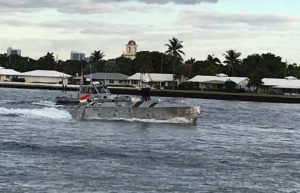The Navy’s top acquisition official said the Navy will be ale to pay for the new unmanned systems in part by gaining efficiencies across platforms to tie unmanned plans and systems together.
“Resources are an important consideration. Requirements without resources are hallucinations,” Assistant Secretary of the Navy for Research, Development and Acquisition James Geurts said during a press call on Sept. 10.

He added that efforts like the unmanned campaign plan will help scale up unmanned efforts more efficiently than working separately on each platform. At the same time, ultimately teaming unmanned systems with manned platforms can add a multiplier effect for outcomes
The unmanned campaign plan was directed by Chief of Naval Operations Adm. Michael Gilday to bring together unmanned aviation, surface, and undersea programs for centralized management and leadership of the enabling technologies. (Defense Daily, Sept. 9).
Geurts argued the close linkages on efforts like the campaign plan between his office with the technical programmatic side and Vice Adm. James Kilby, Deputy Chief of Naval Operations for Warfighting Requirements and Capabilities, N9, on the requirements side is helpful.
“I think why we’re taking this scaled view of things is to gain efficiencies above individual programs, building all these individual capabilities by themselves and thus having to pay again to integrate them. So if I just think of, say, how we’re going to command or control these – we can garner resources by operating more efficiently, not necessarily just by trading off one platform versus another.”
He said they can also gain efficiency by figuring out how to get manned and remotely manned systems to work together for a multiplier effect as opposed to strictly thinking of each platform alone for a more additive effect.
Geurts argued specifically because the Navy expects to be resource constrained “that we’ve really got to take this campaign view, this systematic approach, this integrated approach, this enabling approach to get after it because if we just took a platform-centric approach and built a bunch of individual platforms that all operated individually with their own dedicated X,Y and Z we wouldn’t get there.”
This effort comes after the Navy in 2019 originally planned to retire the USS Harry S. Truman (CVN-75) decades early to help redirect funds to new technologies like unmanned systems. However, after considerable congressional opposition, the administration changed course and said the ship would not be retired (Defense Daily, April 20, 2019).
Geurts argued beyond unmanned systems enhancing distributed operations they also help with distributed sensing.
“If you think of all of these individual platforms as part of a larger network, you can create distributed networks, distributing sensing, distributing capability–which is not only new capabilities we don’t have, they also are inherently more resilient than kind of single platform approaches to some of these capabilities.”
“I think we get additional capability and capacity that we don’t have now just by kind of this more system of systems approach to the challenge,” he added.